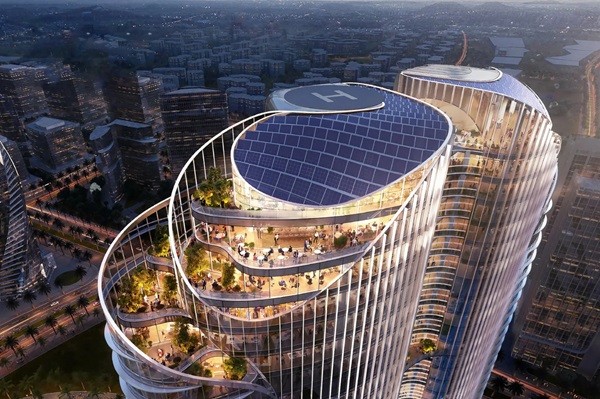
By Edson Baraukwa | Africa Guardian
Forbes is set to build Africa’s first hydrogen-powered skyscraper in Egypt, a 50-story tower that marks a significant milestone in hydrogen innovation on the continent. This ambitious project promises to be a catalyst for the development of more sustainable skyscrapers across Africa.
Egypt is leading the charge in hydrogen innovation with the introduction of the continent’s first “Hydrogen Building,” a towering 50-floor structure. This initiative could open new avenues for hydrogen applications as infrastructure expands across Africa, fueled by growing investments in the sector.
In 2023, Forbes and Magnom Properties, a Saudi Arabian real estate company, announced their partnership to construct the $1 billion skyscraper during the 53rd Annual Meeting of the World Economic Forum (WEF) in Davos, Switzerland. Forbes CEO Mike Federle described the project as “the first sustainable international tower under the Forbes name.”
The skyscraper will rise in the heart of Cairo’s New Administrative Capital, with construction slated to begin in 2025 and completion expected by 2030. Adrian Smith, the lead architect, envisions the final structure as a “contextually responsive design of soaring glass, steel, and photovoltaic elements, featuring captivating curves that ascend to form 55 floors of flexible office space and two stories of premium retail experiences.”
Beyond its architectural and economic significance, this project represents a crucial step in diversifying hydrogen applications across Africa. According to Rystad Energy, the continent’s hydrogen capacity currently stands at over 114 GW, distributed across 52 projects.
Hydrogen is a key focus in Egypt’s energy strategy, with the country aiming to produce and potentially export hydrogen to Europe via the strategic Suez Canal. Egypt’s recent unveiling of a green hydrogen strategy underscores its ambition to become a global leader in green hydrogen exports by 2040. The strategy has strengthened Egypt’s commitment to the sector and attracted significant investor interest.
The World Economic Forum reports that Egypt is seeking up to $40 billion in green hydrogen investments. As part of its efforts to attract investors, Egypt has signed seven memoranda of understanding with various stakeholders. This surge in investor interest mirrors developments in other African countries, particularly in southern Africa, where Namibia and South Africa are seeing significant activity in the hydrogen sector.
A June report by the United Nations Trade and Investment Division highlighted green hydrogen as one of the top subsectors in clean energy that attracted the most investment in 2023.
In recent years, Africa’s skyline has undergone significant transformation as the demand for iconic skyscrapers has grown. Beyond established markets like South Africa, Kenya, and Egypt, new highrises are also emerging in less traditional markets, such as Zanzibar. However, skyscrapers have been criticized for their environmental impact. According to architecttours.com, these structures increase energy consumption, contribute to the heat island effect, alter microclimates, and exacerbate CO2 emissions, all of which contribute to climate change.
A 2022 report, the Global Status Report for Buildings and Construction, found that buildings were responsible for 34% of global energy demand and up to 37% of energy-related emissions in 2021. A 30-story building can emit at least 300,000 tons of greenhouse gases, equivalent to the annual energy use of nearly 40,000 homes.
However, with its vast green hydrogen potential, Africa has the opportunity to pursue more ambitious skyscrapers while significantly reducing emissions during both construction and post-construction phases through the use of clean energy-powered fittings and appliances.
The movement towards sustainable highrises is gaining momentum, as demonstrated by Burj Zanzibar, a $1.3 billion high-rise currently under construction on the archipelago island. This building is being constructed using hybrid timber instead of concrete, with completion expected in 2026.
The proposed Forbes Tower adds to the growing interest in innovating and expanding the use of hydrogen beyond traditional applications. Outside of Egypt, green hydrogen has primarily been used in industrial applications as a cleaner alternative to fossil fuels and, more recently, in the transport sector.
Namibia is already on track to build Africa’s first public green hydrogen fueling station at Walvis Bay on the western coast, which will supply green hydrogen for heavy-duty trucks. Automakers like BMW, which launched a hydrogen-powered test vehicle earlier this year, have expressed confidence in the future of green hydrogen in transportation. Other companies, such as Toyota, have also shown interest, with the Japanese automaker launching the Mirai, a $50,000 hydrogen-powered vehicle, in the U.S.
German research firm McKinsey & Company projects that Africa could generate up to 60 megatons of green hydrogen by 2050, both for domestic use and export.
___
